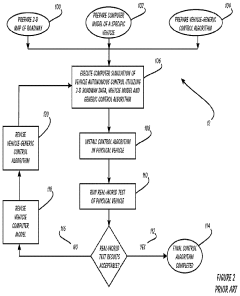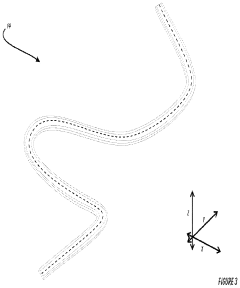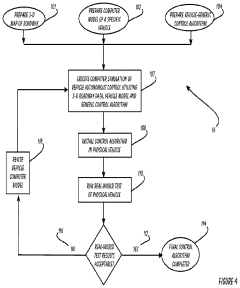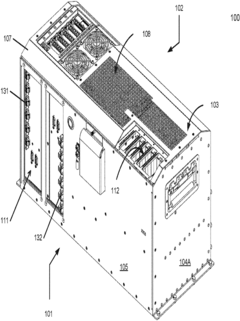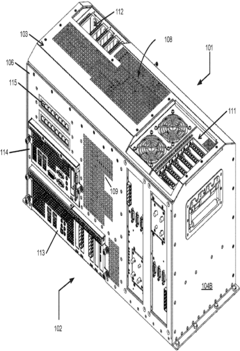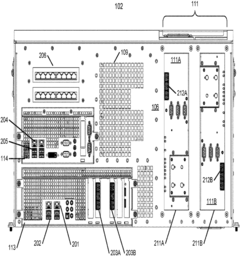How V8 Engines Shape Autonomous Vehicle Capabilities?
JUL 4, 20258 MIN READ
Generate Your Research Report Instantly with AI Agent
Patsnap Eureka helps you evaluate technical feasibility & market potential.
V8 Engine Evolution in Autonomous Vehicles
The evolution of V8 engines in autonomous vehicles represents a significant technological advancement in the automotive industry. Initially designed for high-performance vehicles, V8 engines have undergone substantial modifications to meet the unique demands of self-driving cars. This transformation began with the integration of electronic control units (ECUs) and advanced sensors, allowing for more precise control over engine performance and fuel efficiency.
As autonomous vehicle technology progressed, V8 engines were adapted to support the increased power requirements of complex sensor arrays and onboard computing systems. This led to the development of hybrid V8 powertrains, combining traditional internal combustion with electric motors to provide the necessary power while improving fuel economy and reducing emissions.
The integration of artificial intelligence and machine learning algorithms into engine management systems marked another crucial milestone. These advanced systems enabled real-time optimization of engine performance based on driving conditions, traffic patterns, and even predictive maintenance schedules. This level of sophistication allowed autonomous vehicles to maximize efficiency and reliability, critical factors for self-driving operations.
Recent developments have seen V8 engines in autonomous vehicles becoming more compact and lightweight, thanks to advanced materials and innovative design techniques. This evolution has not only improved the power-to-weight ratio but also enhanced the overall vehicle dynamics, crucial for the precise maneuvering required in autonomous driving scenarios.
The latest generation of V8 engines for autonomous vehicles incorporates advanced thermal management systems and regenerative braking technologies. These innovations have significantly improved energy recovery and utilization, extending the range and operational capabilities of self-driving vehicles. Additionally, the integration of smart cooling systems has allowed for more consistent performance under varying load conditions, essential for the continuous operation of autonomous fleets.
As autonomous vehicle technology continues to advance, V8 engines are being further refined to support higher levels of autonomy. This includes the development of fail-safe systems and redundant power generation capabilities to ensure uninterrupted operation of critical autonomous driving functions. The ongoing evolution of V8 engines in this context demonstrates the adaptability of traditional powertrain technologies to meet the demands of cutting-edge autonomous vehicle systems.
As autonomous vehicle technology progressed, V8 engines were adapted to support the increased power requirements of complex sensor arrays and onboard computing systems. This led to the development of hybrid V8 powertrains, combining traditional internal combustion with electric motors to provide the necessary power while improving fuel economy and reducing emissions.
The integration of artificial intelligence and machine learning algorithms into engine management systems marked another crucial milestone. These advanced systems enabled real-time optimization of engine performance based on driving conditions, traffic patterns, and even predictive maintenance schedules. This level of sophistication allowed autonomous vehicles to maximize efficiency and reliability, critical factors for self-driving operations.
Recent developments have seen V8 engines in autonomous vehicles becoming more compact and lightweight, thanks to advanced materials and innovative design techniques. This evolution has not only improved the power-to-weight ratio but also enhanced the overall vehicle dynamics, crucial for the precise maneuvering required in autonomous driving scenarios.
The latest generation of V8 engines for autonomous vehicles incorporates advanced thermal management systems and regenerative braking technologies. These innovations have significantly improved energy recovery and utilization, extending the range and operational capabilities of self-driving vehicles. Additionally, the integration of smart cooling systems has allowed for more consistent performance under varying load conditions, essential for the continuous operation of autonomous fleets.
As autonomous vehicle technology continues to advance, V8 engines are being further refined to support higher levels of autonomy. This includes the development of fail-safe systems and redundant power generation capabilities to ensure uninterrupted operation of critical autonomous driving functions. The ongoing evolution of V8 engines in this context demonstrates the adaptability of traditional powertrain technologies to meet the demands of cutting-edge autonomous vehicle systems.
Market Demand for High-Performance AVs
The market demand for high-performance autonomous vehicles (AVs) is rapidly evolving, driven by the increasing need for safer, more efficient, and technologically advanced transportation solutions. As urban populations grow and traffic congestion worsens, there is a rising demand for vehicles that can navigate complex environments autonomously while delivering superior performance.
In the luxury and high-end vehicle segments, consumers are showing a strong interest in AVs that combine cutting-edge autonomous capabilities with powerful engines, such as V8s. These consumers are willing to pay a premium for vehicles that offer both the thrill of high-performance driving and the convenience of autonomous operation. This dual demand is pushing automakers to develop AVs that can seamlessly transition between manual and autonomous modes, catering to enthusiasts who still enjoy driving but also want the option of hands-free operation.
The commercial sector is also contributing significantly to the market demand for high-performance AVs. Logistics companies are increasingly looking for autonomous trucks that can operate efficiently over long distances, with V8 engines providing the necessary power for heavy loads and challenging terrains. Similarly, public transportation agencies are exploring high-performance autonomous buses to improve service efficiency and reliability in urban areas.
The ride-hailing industry is another key driver of demand for high-performance AVs. Companies in this sector are investing heavily in autonomous vehicle fleets, recognizing the potential for increased profitability through reduced labor costs and improved vehicle utilization. These companies are particularly interested in AVs that can offer a premium riding experience, including those equipped with powerful V8 engines for smooth acceleration and comfortable high-speed travel.
Law enforcement and emergency services are also showing interest in high-performance AVs. These sectors require vehicles that can respond quickly to emergencies while navigating through traffic autonomously, making V8-powered AVs an attractive option for their fleets.
The market for high-performance AVs is not limited to ground vehicles. There is growing interest in autonomous aircraft and marine vessels that require powerful engines for optimal performance. This expansion into different transportation modes is further broadening the market potential for high-performance autonomous systems.
As environmental concerns become more pressing, there is also a emerging demand for high-performance AVs that balance power with sustainability. This is driving research into more efficient V8 engines and hybrid powertrains that can deliver high performance while minimizing environmental impact, aligning with global efforts to reduce carbon emissions in the transportation sector.
In the luxury and high-end vehicle segments, consumers are showing a strong interest in AVs that combine cutting-edge autonomous capabilities with powerful engines, such as V8s. These consumers are willing to pay a premium for vehicles that offer both the thrill of high-performance driving and the convenience of autonomous operation. This dual demand is pushing automakers to develop AVs that can seamlessly transition between manual and autonomous modes, catering to enthusiasts who still enjoy driving but also want the option of hands-free operation.
The commercial sector is also contributing significantly to the market demand for high-performance AVs. Logistics companies are increasingly looking for autonomous trucks that can operate efficiently over long distances, with V8 engines providing the necessary power for heavy loads and challenging terrains. Similarly, public transportation agencies are exploring high-performance autonomous buses to improve service efficiency and reliability in urban areas.
The ride-hailing industry is another key driver of demand for high-performance AVs. Companies in this sector are investing heavily in autonomous vehicle fleets, recognizing the potential for increased profitability through reduced labor costs and improved vehicle utilization. These companies are particularly interested in AVs that can offer a premium riding experience, including those equipped with powerful V8 engines for smooth acceleration and comfortable high-speed travel.
Law enforcement and emergency services are also showing interest in high-performance AVs. These sectors require vehicles that can respond quickly to emergencies while navigating through traffic autonomously, making V8-powered AVs an attractive option for their fleets.
The market for high-performance AVs is not limited to ground vehicles. There is growing interest in autonomous aircraft and marine vessels that require powerful engines for optimal performance. This expansion into different transportation modes is further broadening the market potential for high-performance autonomous systems.
As environmental concerns become more pressing, there is also a emerging demand for high-performance AVs that balance power with sustainability. This is driving research into more efficient V8 engines and hybrid powertrains that can deliver high performance while minimizing environmental impact, aligning with global efforts to reduce carbon emissions in the transportation sector.
V8 Engine Challenges in AV Integration
The integration of V8 engines into autonomous vehicles (AVs) presents several significant challenges that require innovative solutions. One of the primary issues is the increased power consumption and energy demands of V8 engines compared to smaller, more efficient powertrains. This higher energy requirement can potentially reduce the overall range and operational time of AVs, which is crucial for their practical deployment in various scenarios.
Another challenge lies in the complex control systems needed to manage V8 engines effectively within an autonomous driving context. The sophisticated engine management systems must seamlessly interface with the AV's artificial intelligence and sensor arrays, ensuring optimal performance while maintaining safety and efficiency. This integration demands advanced software development and rigorous testing to achieve the necessary level of reliability and responsiveness.
The physical size and weight of V8 engines also pose challenges for AV design. These larger engines require more space within the vehicle, potentially limiting room for other critical components such as sensors, computers, and batteries. The added weight can affect the vehicle's dynamics, necessitating adjustments to suspension systems and overall chassis design to maintain optimal handling and stability for autonomous operation.
Emissions and environmental concerns present another hurdle in V8 engine integration. As regulations become increasingly stringent, incorporating powerful V8 engines while meeting emission standards becomes more challenging. This necessitates the development of advanced emission control technologies and potentially hybrid systems to balance performance with environmental responsibility.
Noise and vibration management is an additional consideration. V8 engines typically produce more noise and vibration compared to smaller powertrains, which can interfere with the sensitive sensors and equipment used in AVs. Engineers must develop innovative isolation and damping solutions to ensure the smooth operation of autonomous systems without compromising the engine's performance.
Lastly, the cost implications of integrating V8 engines into AVs cannot be overlooked. The higher production and maintenance costs associated with these powerful engines may impact the overall affordability and market viability of AVs equipped with V8 powertrains. Balancing performance benefits with economic feasibility remains a significant challenge for manufacturers and developers in the AV industry.
Another challenge lies in the complex control systems needed to manage V8 engines effectively within an autonomous driving context. The sophisticated engine management systems must seamlessly interface with the AV's artificial intelligence and sensor arrays, ensuring optimal performance while maintaining safety and efficiency. This integration demands advanced software development and rigorous testing to achieve the necessary level of reliability and responsiveness.
The physical size and weight of V8 engines also pose challenges for AV design. These larger engines require more space within the vehicle, potentially limiting room for other critical components such as sensors, computers, and batteries. The added weight can affect the vehicle's dynamics, necessitating adjustments to suspension systems and overall chassis design to maintain optimal handling and stability for autonomous operation.
Emissions and environmental concerns present another hurdle in V8 engine integration. As regulations become increasingly stringent, incorporating powerful V8 engines while meeting emission standards becomes more challenging. This necessitates the development of advanced emission control technologies and potentially hybrid systems to balance performance with environmental responsibility.
Noise and vibration management is an additional consideration. V8 engines typically produce more noise and vibration compared to smaller powertrains, which can interfere with the sensitive sensors and equipment used in AVs. Engineers must develop innovative isolation and damping solutions to ensure the smooth operation of autonomous systems without compromising the engine's performance.
Lastly, the cost implications of integrating V8 engines into AVs cannot be overlooked. The higher production and maintenance costs associated with these powerful engines may impact the overall affordability and market viability of AVs equipped with V8 powertrains. Balancing performance benefits with economic feasibility remains a significant challenge for manufacturers and developers in the AV industry.
Current V8 Solutions for AVs
01 V8 Engine Design and Configuration
V8 engines are designed with eight cylinders arranged in two banks of four, forming a V-shape. This configuration allows for a compact design while providing high power output. Various aspects of V8 engine design, including cylinder arrangement, crankshaft configuration, and valve train systems, are continuously improved to enhance performance and efficiency.- V8 Engine Design and Configuration: V8 engines are designed with eight cylinders arranged in two banks of four, forming a V-shape. This configuration allows for a compact design while providing high power output. The design often includes features for improved performance, fuel efficiency, and reduced emissions.
- Fuel Injection Systems for V8 Engines: Advanced fuel injection systems are developed for V8 engines to optimize fuel delivery and combustion. These systems may include direct injection, multi-port injection, or a combination of both, aiming to improve engine efficiency and reduce fuel consumption while maintaining high performance.
- Valve Train and Camshaft Innovations: Innovations in valve train and camshaft designs for V8 engines focus on improving engine breathing and overall efficiency. This may include variable valve timing, cylinder deactivation systems, and advanced camshaft profiles to enhance performance across different engine speeds and loads.
- Turbocharging and Supercharging V8 Engines: Forced induction systems, such as turbochargers and superchargers, are applied to V8 engines to increase power output and efficiency. These systems compress the intake air, allowing for more fuel to be burned and resulting in higher power output from a smaller displacement engine.
- Cooling and Lubrication Systems for V8 Engines: Specialized cooling and lubrication systems are developed for V8 engines to manage heat and reduce friction. These may include advanced oil pumps, targeted piston cooling jets, and optimized coolant flow paths to ensure engine longevity and maintain performance under high-stress conditions.
02 Fuel Injection and Combustion Optimization
Advanced fuel injection systems and combustion optimization techniques are implemented in V8 engines to improve fuel efficiency and reduce emissions. This includes direct injection technology, variable valve timing, and precise fuel metering systems. These innovations help to maximize power output while minimizing fuel consumption and environmental impact.Expand Specific Solutions03 Turbocharging and Supercharging Systems
V8 engines often incorporate forced induction systems such as turbochargers or superchargers to increase power output and efficiency. These systems compress the intake air, allowing more fuel to be burned and generating more power from the same engine displacement. Various designs and configurations of turbochargers and superchargers are used to optimize performance across different operating conditions.Expand Specific Solutions04 Engine Management and Control Systems
Sophisticated engine management and control systems are crucial for optimizing V8 engine performance. These systems monitor and adjust various parameters such as fuel injection timing, ignition timing, and valve timing in real-time. Advanced sensors and electronic control units (ECUs) are used to ensure optimal engine operation under varying conditions.Expand Specific Solutions05 Materials and Manufacturing Techniques
Innovative materials and manufacturing techniques are employed in V8 engine production to reduce weight, improve durability, and enhance thermal efficiency. This includes the use of lightweight alloys, advanced coatings, and precision manufacturing processes. These advancements contribute to improved performance, fuel efficiency, and longevity of V8 engines.Expand Specific Solutions
V8 Innovations for AV Applications
Method and system for modeling autonomous vehicle behavior
PatentActiveUS20210181744A1
Innovation
- A system and method that utilizes 3-dimensional roadway data to develop and optimize a generic vehicle control algorithm through computer simulations, allowing for real-world testing without needing to revise the control algorithm, focusing on modifying the vehicle computer model instead.
Apparatus for controlling and operating an autonomous vehicle
PatentActiveCN108076609A
Innovation
- A chassis containing a control server compartment, a compute server compartment, and an input-output subsystem compartment was designed to receive sensor data and generate control commands via a PCIe link, using an Ethernet connection to control the autonomous vehicle, incorporating a cooling system and a compact Air circulation design adapts to the car trunk environment.
Environmental Impact of V8 in AVs
The environmental impact of V8 engines in autonomous vehicles (AVs) is a complex and multifaceted issue that requires careful consideration. While V8 engines have traditionally been associated with high performance and power, their use in AVs raises significant environmental concerns.
V8 engines, known for their larger displacement and higher fuel consumption, typically produce more emissions compared to smaller, more efficient engine configurations. In the context of AVs, this increased fuel consumption and emission output can potentially offset some of the environmental benefits expected from autonomous technology. The higher carbon dioxide emissions from V8 engines contribute to climate change and air pollution, which are critical environmental challenges in urban areas where AVs are likely to be deployed first.
However, the environmental impact of V8 engines in AVs is not solely determined by their fuel efficiency. The advanced control systems in AVs can optimize engine performance and driving patterns, potentially mitigating some of the negative environmental effects. For instance, AVs can implement more efficient acceleration and deceleration profiles, reducing unnecessary fuel consumption and emissions.
The manufacturing process of V8 engines for AVs also plays a role in their environmental impact. The production of larger, more complex engines requires more resources and energy, contributing to the overall carbon footprint of the vehicle before it even hits the road. This aspect becomes particularly relevant when considering the lifecycle environmental impact of AVs.
On the other hand, the durability and longevity of V8 engines could potentially offset some of their environmental drawbacks. If these engines can sustain longer operational lifespans in AVs, it might reduce the frequency of vehicle replacements and the associated environmental costs of manufacturing new vehicles.
The choice of fuel for V8 engines in AVs is another critical factor influencing their environmental impact. While traditional gasoline-powered V8 engines have significant environmental drawbacks, the adaptation of V8 architectures to alternative fuels or hybrid systems could potentially mitigate some of these concerns. For example, V8 engines running on biofuels or integrated into hybrid powertrains could offer a balance between performance and environmental responsibility.
As cities and governments worldwide implement stricter emissions regulations, the future of V8 engines in AVs may be challenged. The environmental impact of these powerplants could lead to increased pressure for more efficient alternatives, potentially accelerating the shift towards electric or hydrogen fuel cell powertrains in autonomous vehicles.
V8 engines, known for their larger displacement and higher fuel consumption, typically produce more emissions compared to smaller, more efficient engine configurations. In the context of AVs, this increased fuel consumption and emission output can potentially offset some of the environmental benefits expected from autonomous technology. The higher carbon dioxide emissions from V8 engines contribute to climate change and air pollution, which are critical environmental challenges in urban areas where AVs are likely to be deployed first.
However, the environmental impact of V8 engines in AVs is not solely determined by their fuel efficiency. The advanced control systems in AVs can optimize engine performance and driving patterns, potentially mitigating some of the negative environmental effects. For instance, AVs can implement more efficient acceleration and deceleration profiles, reducing unnecessary fuel consumption and emissions.
The manufacturing process of V8 engines for AVs also plays a role in their environmental impact. The production of larger, more complex engines requires more resources and energy, contributing to the overall carbon footprint of the vehicle before it even hits the road. This aspect becomes particularly relevant when considering the lifecycle environmental impact of AVs.
On the other hand, the durability and longevity of V8 engines could potentially offset some of their environmental drawbacks. If these engines can sustain longer operational lifespans in AVs, it might reduce the frequency of vehicle replacements and the associated environmental costs of manufacturing new vehicles.
The choice of fuel for V8 engines in AVs is another critical factor influencing their environmental impact. While traditional gasoline-powered V8 engines have significant environmental drawbacks, the adaptation of V8 architectures to alternative fuels or hybrid systems could potentially mitigate some of these concerns. For example, V8 engines running on biofuels or integrated into hybrid powertrains could offer a balance between performance and environmental responsibility.
As cities and governments worldwide implement stricter emissions regulations, the future of V8 engines in AVs may be challenged. The environmental impact of these powerplants could lead to increased pressure for more efficient alternatives, potentially accelerating the shift towards electric or hydrogen fuel cell powertrains in autonomous vehicles.
V8 Fuel Efficiency Strategies
V8 engines, traditionally associated with high-performance vehicles, are now being adapted to meet the unique demands of autonomous vehicles. The focus on fuel efficiency strategies for V8 engines in autonomous vehicles is driven by the need to balance power with energy conservation, a critical factor in extending the operational range and reducing the environmental impact of these advanced vehicles.
One key strategy in improving V8 fuel efficiency for autonomous vehicles is the implementation of advanced cylinder deactivation systems. These systems allow the engine to seamlessly switch between operating on all eight cylinders and running on four or even two cylinders, depending on the power requirements. This adaptive approach significantly reduces fuel consumption during low-load conditions, such as highway cruising or urban traffic scenarios, where full engine power is not necessary.
Another important fuel efficiency strategy involves the integration of start-stop technology. This system automatically shuts off the engine when the vehicle comes to a stop and restarts it when motion is required. In the context of autonomous vehicles, this technology can be further optimized by predictive algorithms that anticipate traffic patterns and adjust the engine's operation accordingly, maximizing fuel savings in urban environments.
The incorporation of advanced thermal management systems is also crucial for enhancing V8 fuel efficiency in autonomous vehicles. These systems optimize engine temperature across various operating conditions, reducing friction and improving overall efficiency. Additionally, they can be integrated with the vehicle's autonomous systems to pre-condition the engine based on anticipated driving scenarios, further improving fuel economy.
Electrification plays a significant role in V8 fuel efficiency strategies for autonomous vehicles. Mild hybrid systems, incorporating a small electric motor and battery, can assist the V8 engine during acceleration and allow for energy recuperation during braking. This hybrid approach not only improves fuel efficiency but also provides the instantaneous torque necessary for precise autonomous vehicle control.
Furthermore, the development of intelligent engine management systems tailored for autonomous operation is a key focus area. These systems leverage real-time data from the vehicle's sensors and navigation systems to optimize engine performance continuously. By anticipating road conditions, traffic patterns, and route characteristics, the engine management system can proactively adjust fuel injection, ignition timing, and other parameters to maximize efficiency without compromising performance.
Lastly, the integration of advanced materials and manufacturing techniques in V8 engine design contributes significantly to fuel efficiency. Lightweight alloys, low-friction coatings, and precision-engineered components reduce overall engine weight and internal friction, leading to improved fuel economy. These advancements, combined with the sophisticated control systems of autonomous vehicles, create a synergy that pushes the boundaries of V8 engine efficiency in self-driving applications.
One key strategy in improving V8 fuel efficiency for autonomous vehicles is the implementation of advanced cylinder deactivation systems. These systems allow the engine to seamlessly switch between operating on all eight cylinders and running on four or even two cylinders, depending on the power requirements. This adaptive approach significantly reduces fuel consumption during low-load conditions, such as highway cruising or urban traffic scenarios, where full engine power is not necessary.
Another important fuel efficiency strategy involves the integration of start-stop technology. This system automatically shuts off the engine when the vehicle comes to a stop and restarts it when motion is required. In the context of autonomous vehicles, this technology can be further optimized by predictive algorithms that anticipate traffic patterns and adjust the engine's operation accordingly, maximizing fuel savings in urban environments.
The incorporation of advanced thermal management systems is also crucial for enhancing V8 fuel efficiency in autonomous vehicles. These systems optimize engine temperature across various operating conditions, reducing friction and improving overall efficiency. Additionally, they can be integrated with the vehicle's autonomous systems to pre-condition the engine based on anticipated driving scenarios, further improving fuel economy.
Electrification plays a significant role in V8 fuel efficiency strategies for autonomous vehicles. Mild hybrid systems, incorporating a small electric motor and battery, can assist the V8 engine during acceleration and allow for energy recuperation during braking. This hybrid approach not only improves fuel efficiency but also provides the instantaneous torque necessary for precise autonomous vehicle control.
Furthermore, the development of intelligent engine management systems tailored for autonomous operation is a key focus area. These systems leverage real-time data from the vehicle's sensors and navigation systems to optimize engine performance continuously. By anticipating road conditions, traffic patterns, and route characteristics, the engine management system can proactively adjust fuel injection, ignition timing, and other parameters to maximize efficiency without compromising performance.
Lastly, the integration of advanced materials and manufacturing techniques in V8 engine design contributes significantly to fuel efficiency. Lightweight alloys, low-friction coatings, and precision-engineered components reduce overall engine weight and internal friction, leading to improved fuel economy. These advancements, combined with the sophisticated control systems of autonomous vehicles, create a synergy that pushes the boundaries of V8 engine efficiency in self-driving applications.
Unlock deeper insights with Patsnap Eureka Quick Research — get a full tech report to explore trends and direct your research. Try now!
Generate Your Research Report Instantly with AI Agent
Supercharge your innovation with Patsnap Eureka AI Agent Platform!

